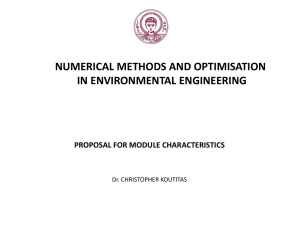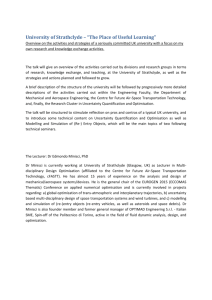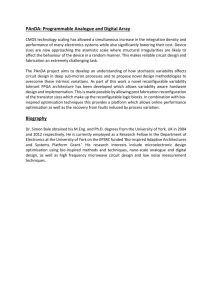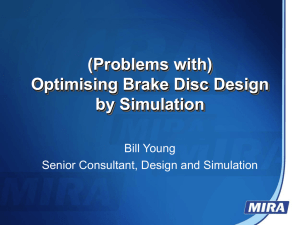Problems to - Introduction to Evolutionary Computing
advertisement
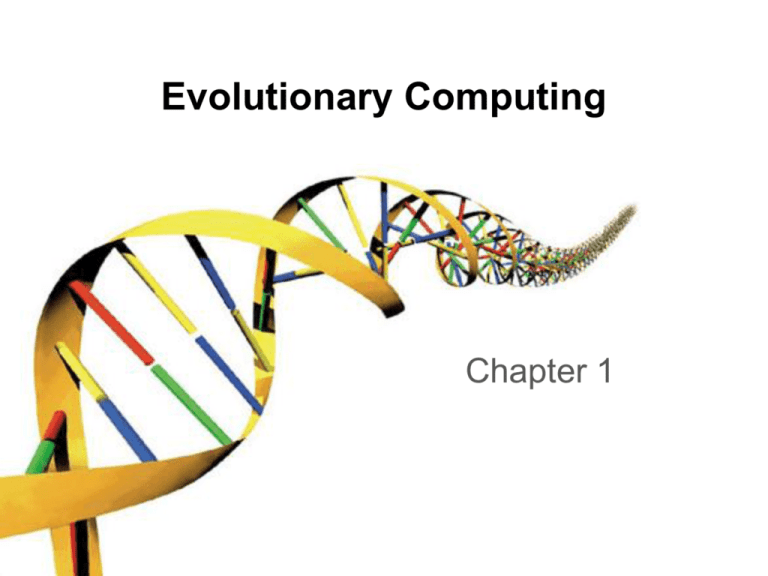
Evolutionary Computing Chapter 1 Chapter 1: Problems to be solved Problems can be classified in different ways: • Black box model • Search problems • Optimisation vs constraint satisfaction • NP problems 2 / 20 “Black box” model • “Black box” model consists of 3 components • When one component is unknown: new problem type 3 / 20 “Black box” model: Optimisation • Model and desired output is known, task is to find inputs • Examples: • • • • Time tables for university, call center, or hospital Design specifications Traveling salesman problem (TSP) Eight-queens problem, etc. 4 / 20 “Black box” model: Optimisation example 1: university timetabling • Enormously big search space • Timetables must be good • “Good” is defined by a number of competing criteria • Timetables must be feasible • Vast majority of search space is infeasible 5 / 20 / 20 “Black box” model: Optimisation example 2: satellite structure • Optimised satellite designs for NASA to maximize vibration isolation • Evolving: design structures • Fitness: vibration resistance • Evolutionary “creativity” 7 / 20 “Black box” model: Optimisation example 3: 8 queens problem • Given an 8-by-8 chessboard and 8 queens • Place the 8 queens on the chessboard without any conflict • Two queens conflict if they share same row, column or diagonal • Can be extended to an n queens problem (n>8) 8 / 20 “Black box” model: Modelling • We have corresponding sets of inputs & outputs and seek model that delivers correct output for every known input • Note: modelling problems can be transformed into optimisation problems • Evolutionary machine learning • Predicting stock exchange • Voice control system for smart homes 9 / 20 “Black box” model: Modelling example: load applicant creditibility • British bank evolved creditability model to predict loan paying behavior of new applicants • Evolving: prediction models • Fitness: model accuracy on historical data 10 / 20 “Black box” model: Simulation • We have a given model and wish to know the outputs that arise under different input conditions • Often used to answer “what-if” questions in evolving dynamic environments – – – Evolutionary economics, Artificial Life Weather forecast system Impact analysis new tax systems 11 / 20 “Black box” model: Simulation example: evolving artificial societies Simulating trade, economic competition, etc. to calibrate models Use models to optimise strategies and policies Evolutionary economy Survival of the fittest is universal (big/small fish) 11 / 20 “Black box” model: Simulation example 2: biological interpretations Incest prevention keeps evolution from rapid degeneration (we knew this) Multi-parent reproduction, makes evolution more efficient (this does not exist on Earth in carbon) 2nd sample of Life 13 / 20 Search problems • Simulation is different from optimisation/modelling • Optimisation/modelling problems search through huge space of possibilities • Search space: collection of all objects of interest including the desired solution • Question: how large is the search space for different tours through n cities? Benefit of classifying these problems: distinction between - search problems, which define search spaces, and - problem-solvers, which tell how to move through search spaces. 14 / 20 Optimisation vs. constraint satisfaction (1/2) • Objective function: a way of assigning a value to a possible solution that reflects its quality on scale – Number of un-checked queens (maximize) – Length of a tour visiting given set of cities (minimize) • Constraint: binary evaluation telling whether a given requirement holds or not – Find a configuration of eight queens on a chessboard such that no two queens check each other – Find a tour with minimal length where city X is visited after city Y 15 / 20 Optimisation vs. constraint satisfaction (2/2) • When combining the two: Objective function Constraints Yes No Yes Constrained optimisation problem Constraint satisfaction problem No Free optimisation problem No problem • Where do the examples fit? • Note: constraint problems can be transformed into optimisation problems • Question: how can we formulate the 8-queens problem in to a FOP/CSP/COP? 16 / 20 NP problems • We only looked at classifying the problem, not discussed problem solvers • This classification scheme needs the properties of the problem solver • Benefit of this scheme: possible to tell how difficult the problem is • Explain the basics of this classifier for combinatorial optimisation problems (booleans or integers search space) 17 / 20 NP problems: Key notions • Problem size: dimensionality of the problem at hand and number of different values for the problem variables • Running-time: number of operations the algorithm takes to terminate – Worst-case as a function of problem size – Polynomial, super-polynomial, exponential • Problem reduction: transforming current problem into another via mapping 18 / 20 NP problems: Class • The difficultness of a problem can now be classified: – Class P: algorithm can solve the problem in polynomial time (worst-case running-time for problem size n is less than F(n) for some polynomial formula F) – Class NP: problem can be solved and any solution can be verified within polynomial time by some other algorithm (P subset of NP) – Class NP-complete: problem belongs to class NP and any other problem in NP can be reduced to this problem by al algorithm running in polynomial time – Class NP-hard: problem is at least as hard as any other problem in NP-complete but solution cannot necessarily be verified within polynomial time 19 / 20 NP problems: Difference between classes • P is different from NP-hard • Not known whether P is different from NP P ≠ NP P = NP • For now: use of approximation algorithms and metaheuristics 20 / 20
